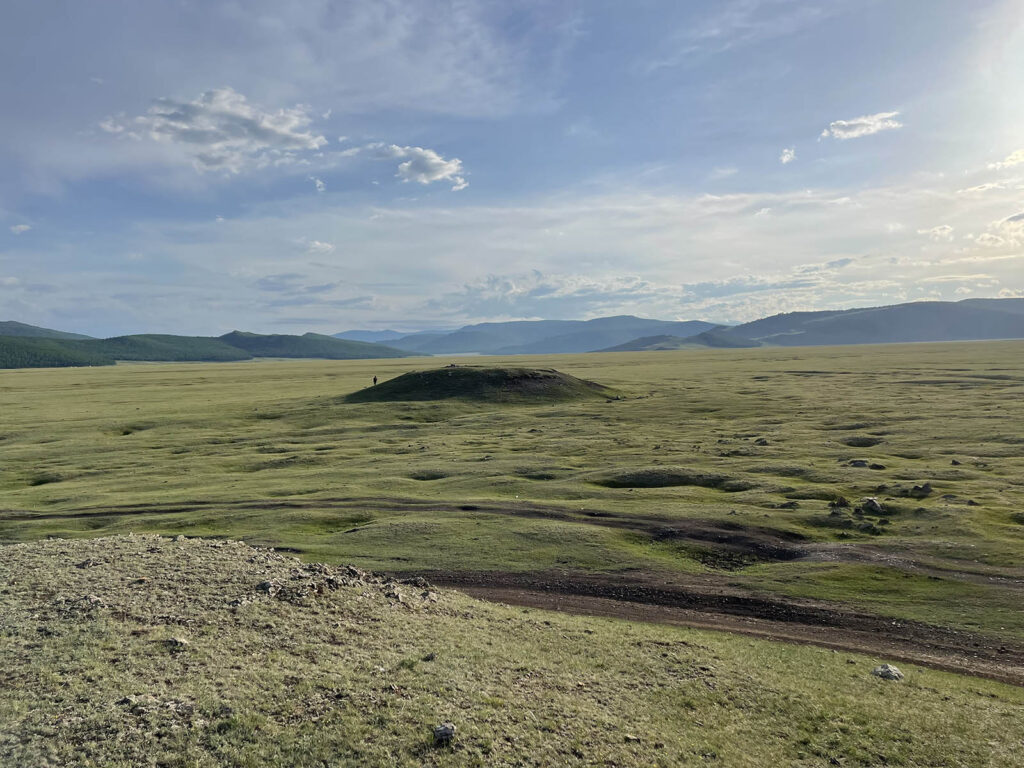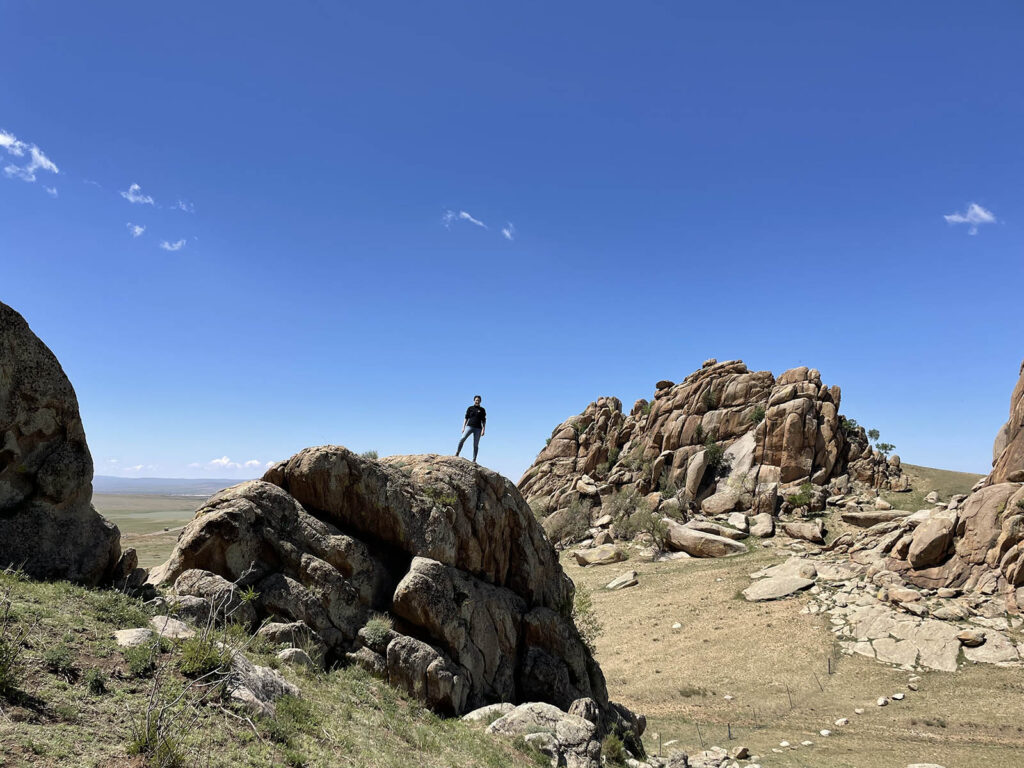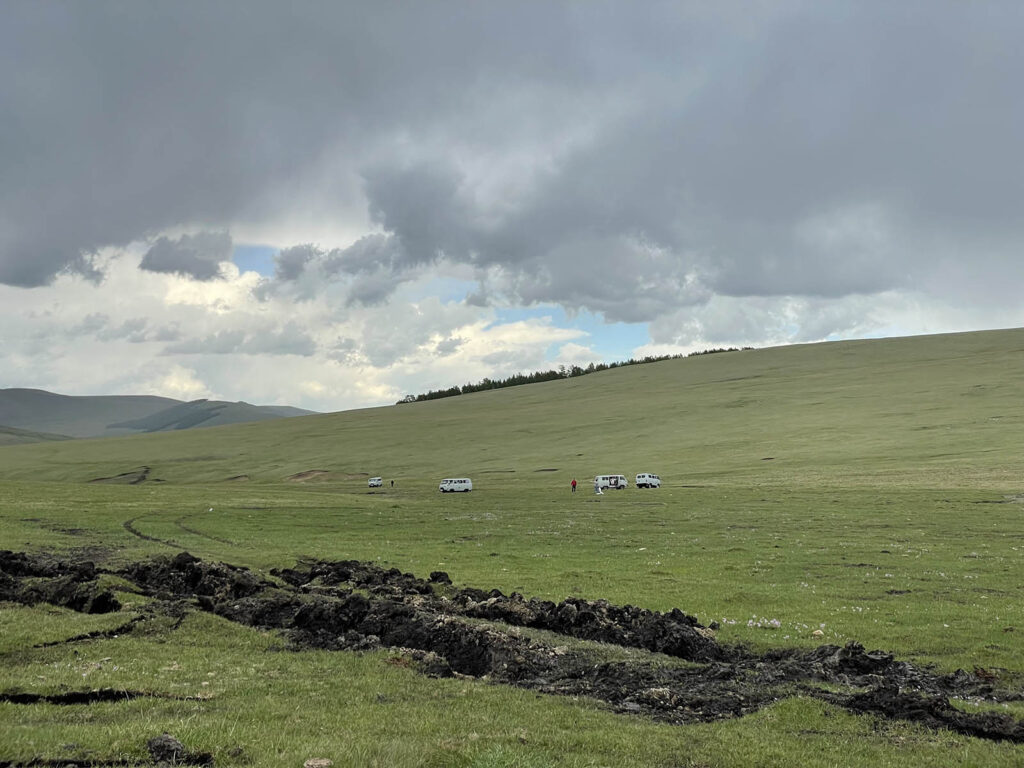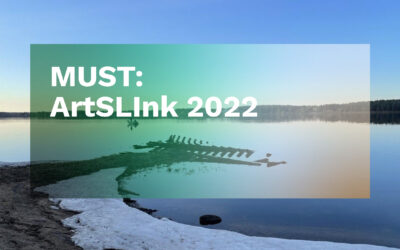In June 2022, a research team comprising Mongolian, American, and Russian researchers traveled to the province to learn more about the communities, relationships with their animals, informal roads, and the landscape. The researchers’ work is part of the “Informal Roads: The Impact of Unofficial Transportation Routes on Remote Arctic Communities” project funded by the US National Science Foundation.



The research team covered approximately 3,000 km in 10 days by UAZ van, manually operated ferry, horseback, and hiking. The team documented the trip through photographs and accounts from two communities, Tsagaannuur and Bayanzurkh.
Mongolia’s northern province of Khövsgöl Aimag is a diverse region with permafrost and cold-climate landscapes that include steppe, taiga, and alpine tundra. It is home to the nomadic Dukha and the Darkhad peoples who rely on seasonal migrations to manage their cattle and reindeer.
The Darkhad Depression is named after Indigenous people who practice traditional herding within the valley. Their cattle, horses, sheep, goat, camels, and yak herds roam in the valley and nearby forests, providing milk, meat, clothing, and transportation for the Darkhad. Sheep and goat wool, horse and yak meat, and gathered pine nuts and berries are also sold for income.




Darkhad cattle herding families migrate four to six times a year depending on annual fluctuations in grazing quality of pasturelands. Light and easily assembled traditional gers, or Mongolian yurts, are made of wood covered in felt or canvas. Circular footprints of former ger locations remain visible for several years as seen from drone images.

The Dukha people have close relationships with their reindeer, which led to their Mongolian name, Tsaatans, meaning “reindeer-herding people.” These intimate human-reindeer connections include not only the provision of food (meat and milk) and transportation but also spiritual and emotional ties. The Dukha people live primarily in areas referred to as the Eastern and Western Taiga. The Western Taiga Dukha generally have more reindeer and preserve what they consider to be more traditional reindeer herding practices.




The overall population who identify as Dukha is rapidly decreasing: from 296 registered Dukha in 2000 to only 189 in 2021**.
Almost all of Khovsgol Aimag is underlain by continuous permafrost or permanently frozen ground. It benefits cattle herders by providing additional moisture to pasturelands during drought seasons due to its slow thaw.

However, when permafrost thaws repeatedly due to vehicle traffic, it can cause ground subsidence, also called thermokarst. During the summer months, vehicles often get stuck in thermokarst depressions that form due to these processes. Thermokarst processes also lead to the formation of many thaw lakes that herders use as drinking water sources. Before constructing ortz, which are yurts resembling Native American tipis, the Dukha people stamp the ground and listen for reverberations to avoid permafrost close to the surface. If not carefully located, wood stoves used for heat and cooking inside the ortz can produce enough heat to thaw the underlying permafrost and cause thermokarst.




Bayanzürkh



The community of Bayanzürkh (from the Mongolian for “rich heart”) was founded at the confluence of the Altraga and Beltes Rivers in 1931 when Darkhad cattle herders were undergoing collectivization by the socialist Mongolian People’s Republic. Bayanzürkh’s population is around 4,200 people and is the first settlement you meet when entering Darkhad Valley. The tentative nature of the community’s connection with others via the bridge does not appear to be as concerning to locals as issues of shared pasture degradation.
Tsagaannuur


Tsagaannuur (Mongolian for “White Lake”) was man-made in the 1920s as part of a fish factory infrastructure initiative by the new Mongolian Soviet regime. Traditional migration routes were disrupted when people were forced to settle in the Eastern Taiga village. Adults settled in the village were then coerced to work in the new factory and children were enrolled in the village boarding school. While some Dukha resumed reindeer herding in the 1990s after the peaceful democratic revolution, some families continue to migrate close to or into the village for children to attend the school year. During the Soviet era, the village was connected by a gravel road with southern sums, or districts, and the regional apital, Mörön. Few of these Soviet gravel roads remain intact.
Traveling by mör, or trails, through the steppe, taiga, and mountain tundra of Northern Mongolia, we, the Mongolian-American-Russian research team, listened to many stories and also experienced first-hand, the challenges and disruptions to travel caused by unprecedented environmental changes occurring throughout the region. Previous research on the area has documented warming air temperatures, shorter winters, thawing permafrost, and changing weather patterns*. Pasturelands throughout Northern Mongolia are strained not only by climate change but larger cattle herds and increased vehicle traffic. Degrading pasturelands produce less forage for grazing animals and are more prone to hazards, including erosion, floods, desertification, and landslides, and mudflows.
While Darkhad and Dukha communities are adapting to these rapidly changing environmental conditions, there are many opportunities for the effective use of new technologies and economic investment to better support and sustain the unique indigenous Northern Mongolian ways of life. We hope this album shares some experiential insights and stimulates discussions for future collaborative research, policy development, and sustainability planning.
Written by Vera Kuklina, Khadbaatar Sandag, Kelsey Nyland, Dmitrii Kobylkin, Mariia Kuklina.
* Küçüküstel, S. (2021). Embracing Landscape: Living with Reindeer and Hunting among Spirits in South Siberia. New York: Berghahn Books
** Хүн ам, орон сууцны 2020 оны ээлжит тооллогын нэгдсэн дүн. Тайлан. Хөвсгөл аймгийн статистикийн хэлтэс, Мөрөн хот. (2020). (Total amount 2020 year's regular census of population and housing, Хovsgol province, murun, 2020)
This bi-lingual album is an effort to share our preliminary results with both local and Indigenous communities (in Mongolian) and with a broader audience (in English)
Vera Kuklina, Khadbaatar Sandag, Kelsey Nyland, Dmitrii Kobylkin, Mariia Kuklina. (2023). МӨР: Following Nomadic Tracks and Trails in Northern Mongolia. Ulaanbaatar: Admont Press.
Text by Vera Kuklina, Kelsey Nyland
Translated by Khadbaatar Sandag
Comments by Vera Kuklina
Drone imagery by Dmitrii Kobylkin
Photos by Mariia Kuklina, Vera Kuklina, Kelsey Nyland, Khadbaatar Sandag, Dmitrii Kobylkin
Design by Olga Zaslavskaya and Stanislav Podusenko








